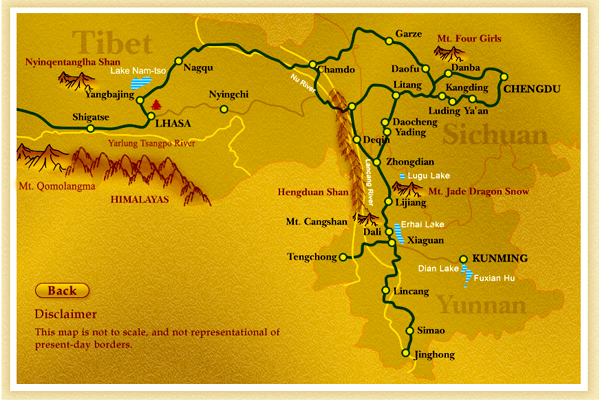
 |
|
File photo shows the road map of the "ancient tea-horse road". The map is not to scale or representation of present-day borders. |
Starting from 2,700 B.C. of China's Xia Kingdom, trade between Tibetan ancestors living on the Qinghai-Tibet Plateau and inland China thrived in the Tang Dynasty (618-917 A.D.) when a large number of Pu'er tea produced in Yunnan were sold to Tibet through the famous "ancient tea-horse road", which played a major role in trans-regional trade in the southwest of China, as important as another famous trade route the "the Silk Rroad".
Booming in the Ming Dynasty and the Qing Dynasty period (1368-1911 A.D.), the ancient tea-horse route collected locally produced Pu'er tea, passed through a number of transfer stations including Yunnan's Lijiang, Sichuan's Litang, Tibet's Chamdo, Nyingchi, Lhasa, Shigatse and Lhoka, and finally reached the neighboring countries such as India, Nepal and Bhutan, as well as further destinations in west Asia and Africa.
According to a historical work named "Man Shu" (literally means "an encyclopedia about today's southwest China and southeast Asia") of the Tang Dynasty, the tea trade through the ancient tea-horse road became so prosperous that there were thousands of merchants coming from Tubo, an ancient kingdom ruling the Qinghai-Tibet Plateau for hundreds of years.
The reason why Pu'er tea is so welcomed in Tibet is explained: "the staple food of Tubo includes livestock meat and highland barley, the former of which is greasy and the latter is dry. And tea is the only thing that can offset these adverse impacts. Thus, the tea, only some leaves though, is so important that it can influence a kingdom".
In 634 AD, six years before Songtsen Gampo (617-650, king of the Tubo Kingdom) married Tang Dynasty's Princess Wencheng, the Tudo Kingdom occupied Dechen and introduced the Kargyu Sect of Tibetan Buddhism to Tibetan inhabited areas in Yunnan, where Karma Kargyu Sect and Phagdru Kargyu Sect are the main sects among the many branches of the Kargyu Sect itself.
The founder of the Karma Kargyu Sect is Karmapa Dusum Khyenpa (1110-1193 AD), the disciple of Dakpo Lhaje and an eminent lama of Kargyu Sect. During his pilgrimage to Jizu Mountain in 1147 AD he was presented over 50 packs of Pu'er Tea by the king of Dali Kingdom and the Mu's Clan in Lijiang, which established the Pu'er tea donation relationship.
In 1256 AD Karmapa Dusum Khyenpa's disciple Karma Pakshi was granted a black hat, a golden seal and a large number of Pu'er tea, all of which were precious gifts in their eyes, and was conferred as "Great Treasure Dharma Lord" by the Mongolian Khan, whose successor later became the emperor of the inland China's Yuan Dynasty(1271-1368 AD).
From then on Karmapa Dusum Khyenpa was retroactively recognized as the first living Buddha of the Black Hat System, and this endorsement also began the reincarnation of living Buddha in the history of Tibetan Buddhism, and tea, especially Pu'er tea, became an important part of offerings in Tibetan Buddhism.
Around 1615 AD upon the invitation from the chieftain of the Mu's Clan, Ngawang Chokyi Wangchuk, the 6th Shamarpa Rinpoche (1584-1635, when the inland China was the Ming Dynasty) of the Red Hat Karma Kargyu Sect of Tibetan Buddhism went to Tibetaninhabited areas in Yunnan to supervise the printing of the "Lijiang version Kangyur" and attend the consecration ceremony, during which he was donated more than 100 packs of Pu'er tea from the chieftain who also sponsored him to renovate the cultivation cave of patriarch Baima Zhupu later on.
In 1649, Choying Dorje the 10th Karmapa Rinpoche of the Black Hat Karma Kargyu Sect of Tibetan Buddhism visited Yunnan as well to offer Shramanera and Bhikshu consecration rituals for over 1,000 monks and followers under the administration of the Mu's. The Mu's clan donated plenty of Pu'er tea in return again.
And in 1660, all Rinpoches of the mother monasteries under the Karma Kargyu Sect gathered in the Tibetan-inhabited areas in Yunnan and the Mu Chieftain donated bountiful Pu'er tea along with gold and silver.
With the 1st Karmapa Dusum Khyenpa being conferred as "Great Treasure Dharma Lord" in 1256, and the 1st Karma Kargyur Red Hat Shamarpa Drakpa Sengge being conferred as "State preceptor" of the Yuan court in 1330, Karmapa has enjoyed sublime authority across Tibet, and the Pu'er tea market became prosperous all over the Tibetan area since the two Karmapa Rinpoches of both the Red and Black Hat liked to drink Pu'er tea and established "Karmapa Yoga Tea Ceremony".
That promoted the sale of Pu'er in other Tibetan-inhabited areas in China and India, Nepal and Bhutan greatly, which even led to a fetish with Pu'er among the people in Tibetan-inhabited areas.